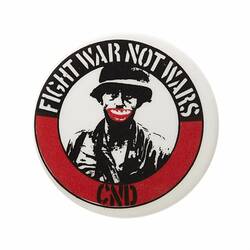The initials CND are printed across this badge, signalling that it was initially made for the British organisation Campaign for Nuclear Disarmament. However, the donor of this badge, Nic Maclellan, thinks that it might have been re-issued in Australia using the British original design. The badge relates to a 1978 song by Crass called Fight War not Wars, in which this line is repeated over and over again. Formed in 1977 in the UK, Crass was more than just a punk band; it was a movement, an entity determined to change the world. A comparison between Sex Pistols and Crass, for example, points to the fact that while 'the former encouraged bored teenaged everywhere to get off their arses and start their own bands, the latter encouraged them to think for themselves' (Glasper, 2014). They built on the general rebellion and chaos of the previous generation but the novelty consisted of a strong social direction and concrete political tone. Their record label Crass Records allegedly managed to sell 1,5 million records without mainstream support. This refusal to 'sell out' earned them a strong following of young radicals and disaffected youth. Their stance was one that can best be described as aggressive pacifism. Commentators note how 'when Crass got mad, they got really mad, and they were ranting and raving at the UK during a mean and miserable time, when Labour buckled and Thatcher took over' (Engelen, 2011). The music Crass produced was deeply intertwined with the contemporary state of British society in the late 70s: brutality, strikes, cynicism, and poverty. Their lyrics are constantly challenging the status quo by tackling anti-militarism, feminism and animal rights.
Crass was also a community that met in Dial House, a squat-cum-artistic commune. Punk aesthetics were an integral part of the Crass movement, with Gee Vaucher in charge of that as their graphic designer. She created most of their record sleeves, including the one for their most popular album, The Feeding of the 5000. Working in media such as photorealistic painting and collage, the one constant in Vaucher's art is a sense of provocative political activism. Talking about her aims, Vaucher mentions 'I found it a very useful tool to get people to look at a subject that wasn't very nice to look at usually. That they would be drawn in, not realising they were looking at a rotting corpse. I found that quite interesting - as they drew back they realise, but it was too late' (Berger, 2009). Her work bears the traditional traits of collage, mostly appropriating pictures of political leaders, advertisements and photojournalism. The style is angry, direct and ideological, much like the style of the music. Its disarming sincerity goes hand in hand with its unapologetically DIY ethos. The collage on this badge initially appeared on the cover of the 1977 Crass newspaper International Anthem - Nihilist Newspaper for the Living.
The anarcho-punk philosophy of the group influenced and contributed to the development of the anarchist and anti-war movement more widely. While it is clear that Crass influenced the CND in the late 1970s and early 1980s, the extent of its reach is debatable. There was definitely an increase in political sentiment and radical pacifist mobilisation after they made The Feeding of the 5000. Around the same period, the membership of the CND also surged. John Savage called this album "the first of a sequence of media (records, slogans, books, posters, magazines, films, actions and concerts) so complex ... and so effective that they sowed the ground for the return of serious anarchism and the popularity of CND in the early I980s' (McKay, 2004). There was a self-awareness inside of the movement as well, with member Penny Rimbaud noting 'we were responsible for introducing it [CND] to thousands of people who would later become the backbone of its revival. A new and hitherto uninformed sector of society was being exposed to a form of radical thought that culminated in the great rallies of the early eighties' (McKay, 2004). However the official CND structures, perhaps concerned at the radicalism of the band, banned them from playing at official concerts.
Reference List
Berger, G. (2009) The Story of Crass. Oakland: PM Press
Engelen, J. (2011) Crass - Anarcho Punk, Thatchergate, Multimedia, Art, Gigs and more. Available at: http://www.dedeceblog.com/2011/03/13/crass-collection [Accessed 07.12.2016]
Glasper, I. (2014) The Day the Country Died: A History of Anarcho Punk 1980-1984. Oakland: PM Press
McKay, G. (2004) Subcultural Innovations in the Campaign for Nuclear Disarmament. Peace Review, 16:4, December, p. 429-438
More Information
-
Keywords
Political Protests, Anti-War Demonstrations, Peace Movements, Peace, Wars & Conflicts, Nuclear Disarmament, Anti-Nuclear Protests, Music, Music Band
-
Authors
-
Article types

